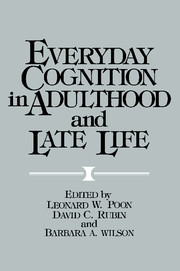Book contents
- Frontmatter
- Contents
- List of contributors
- Preface
- Part I Adult cognitive abilities in the laboratory and in real-life settings: Basic theoretical and methodological issues
- Part IA Systematic approaches to laboratory and real-world research
- 2 Representative design and the quality of generalization
- 3 The myth of external validity
- 4 Functional explanations of memory
- 5 General systems theory: A rationale for the study of everyday memory
- Part IB Combining laboratory and real-world research
- Part II Cognition in adulthood and late life: Findings in real-life settings
- Part IIA Everyday cognitive abilities
- Part IIB Concomitant influences
- Part III Cognitive enhancement and aging: Clinical and educational applications
- Part IIIA Issues and perspectives
- Part IIIB Enhancement approaches
- Part IIIC Designing programs for cognitive rehabilitation
- Subject index
- Author index
2 - Representative design and the quality of generalization
Published online by Cambridge University Press: 05 October 2013
- Frontmatter
- Contents
- List of contributors
- Preface
- Part I Adult cognitive abilities in the laboratory and in real-life settings: Basic theoretical and methodological issues
- Part IA Systematic approaches to laboratory and real-world research
- 2 Representative design and the quality of generalization
- 3 The myth of external validity
- 4 Functional explanations of memory
- 5 General systems theory: A rationale for the study of everyday memory
- Part IB Combining laboratory and real-world research
- Part II Cognition in adulthood and late life: Findings in real-life settings
- Part IIA Everyday cognitive abilities
- Part IIB Concomitant influences
- Part III Cognitive enhancement and aging: Clinical and educational applications
- Part IIIA Issues and perspectives
- Part IIIB Enhancement approaches
- Part IIIC Designing programs for cognitive rehabilitation
- Subject index
- Author index
Summary
I consider the title of this section of the conference, “Theoretical Reasons for a Choice” (between the laboratory and everyday life), to be a bit misleading because, really, there is no necessity for choice. The issue should be considered from the perspective of adopting sampling strategies that will support the scientific generalization to be drawn: Do the sampling procedures support the inference from the particular samples chosen to the universes of interest?
Brunswikian representative design
To begin, I shall briefly describe some Brunswikian views regarding research strategies and develop these ideas within a sampling framework. Brunswik (1952, 1956) argued that we should build a science adequate to understand the behavior of organisms in their environment and should adopt research strategies appropriate to that undertaking. Because behavior takes place in a semichaotic medium that contains cues of limited trustworthiness, expressed vicariously, a research strategy different from those usually advocated will be necessary to realize this understanding. This strategy is called probabilistic functionalism; it utilizes representative design and is adequate to the task of conceptualizing and understanding complex behavior (Petrinovich, 1979). Unfortunately, it is not a simple conceptualization, nor is it easy to implement.
The Brunswikian argument can be conceived as an exercise in sampling theory. First, there is agreement between proponents of representative design and systematic design that it is essential to obtain a representative sample of subjects on which to base theoretical conclusions of general applicability.
- Type
- Chapter
- Information
- Everyday Cognition in Adulthood and Late Life , pp. 11 - 24Publisher: Cambridge University PressPrint publication year: 1989
- 9
- Cited by



